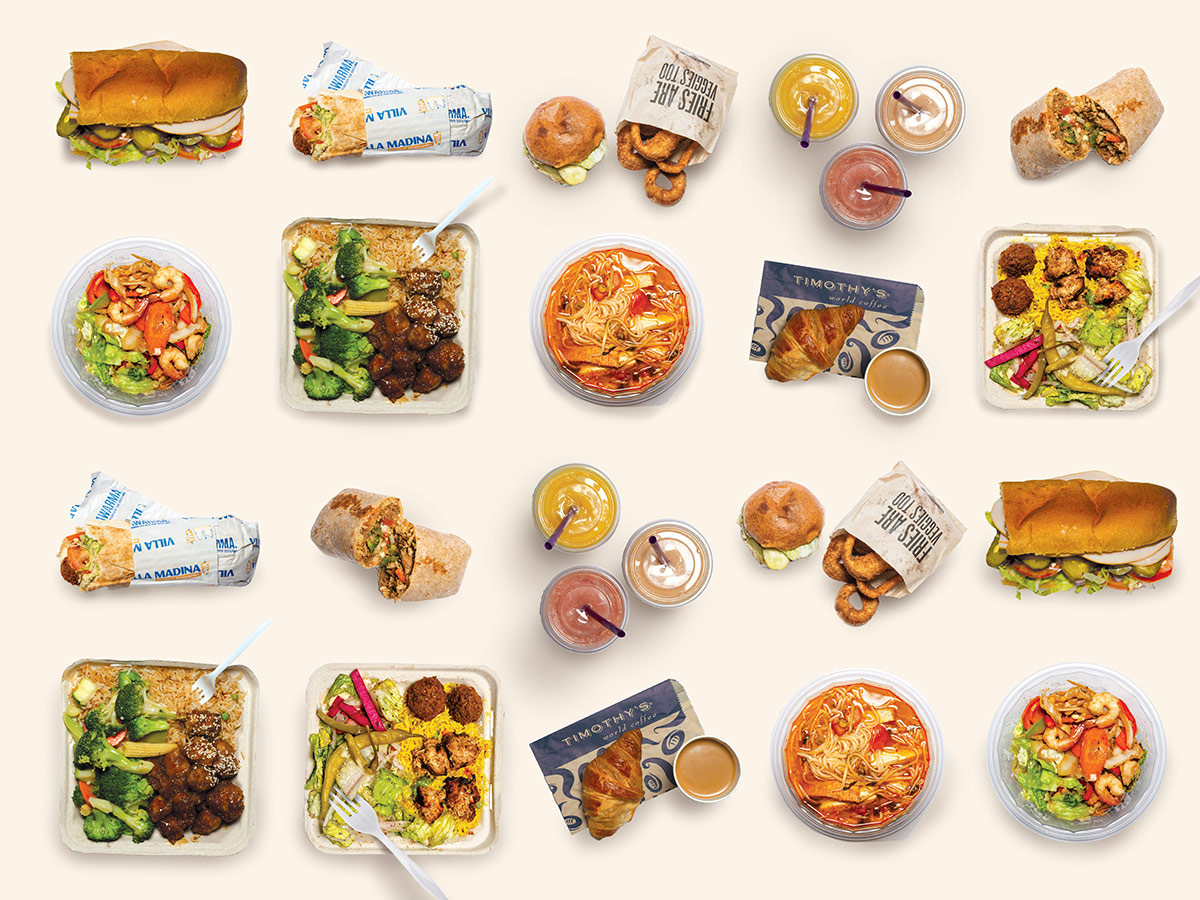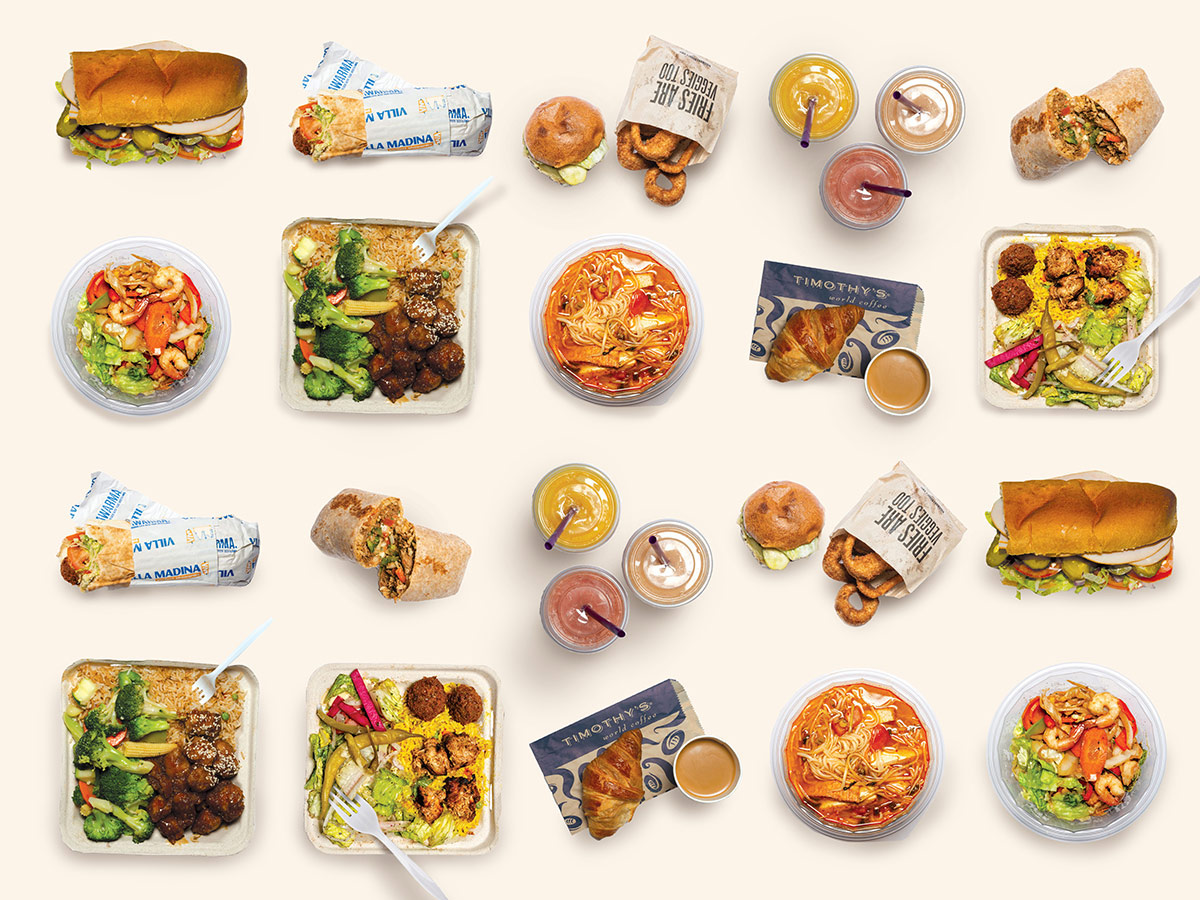
You’ve eaten this CPA’s food, whether you know it or not
 The MTY Food Group Inc. is one of the largest restaurant franchisors in North America (Photographs by Daniel Neuhas)
The MTY Food Group Inc. is one of the largest restaurant franchisors in North America (Photographs by Daniel Neuhas)
If you’ve noshed at a shopping mall in the last two decades, chances are you’ve enriched MTY Group’s bottom line. And you probably had no idea you were doing so, which is exactly what the company—which fills food-court trays with burgers, pizza, subs, sweet-and-sour pork, salad, smoothies, BBQ, tacos, pad Thai, tandoori chicken, vegetarian quiche, sushi, souvlaki, poutine or pretty much whatever might tempt your palate—wants.
The head office of MTY Food Group Inc., one of the largest restaurant franchisors in North America, sits beside a pothole-strewn service road on the industrial outskirts of Montreal. Inside, it’s all narrow hallways, leatherette furniture and cramped offices—a testament to blandness.
It’s a notable counterpoint to the MTY Group’s technicolour roster, which numbers about 75 restaurant brands in Canada and the U.S., and in 35 other countries around the world. “We like being discreet,” says MTY CEO Eric Lefebvre, a CPA. “We want each restaurant to have its own identity, its own personality. When people go into one of our restaurants, we don’t necessarily want them to know they are going into an MTY restaurant.”
Lefebvre is the personification of this discretion. The trim 42-year-old Quebec native is the company’s second-ever CEO. On the day I met him, he padded around the office in a jacket and open-necked white shirt, apologizing to employees when he invariably bumped into them in the halls. He lists “work” as his prime hobby. And since his arrival in 2009, MTY has undergone the biggest growth spurt in its history.
In 2010, the company oversaw 1,727 locations; in 2017, there were 5,469. Sales increased by nearly $2 billion, to $2.3 billion, during the same time period. The company has grown through a decade when the very notion of fast food has been attacked as unhealthy, in part by buying up brands offering healthier fare and altering the menus of many in the stable to address consumer health concerns.
And it has grown by procuring brand after brand of mostly shopping mall-based fare—at a time when the drawing power of malls is supposedly ebbing toward irrelevance. It’s the kind of counterintuitive move that made MTY such a player in the first place.
 MTY CEO Eric Lefebvre, CPA (Photograph by Guillaume Simoneau)
MTY CEO Eric Lefebvre, CPA (Photograph by Guillaume Simoneau)
The company headwaters flow directly from a working-class piece of the Montreal suburb Laval, where founder Stanley Ma opened his first restaurant.
Ma came to Montreal in 1968 from Hong Kong, landing in an era of continual political upheaval. Montreal’s French and English solitudes lived on opposite sides of the city, with Saint-Laurent Boulevard acting as a moat between the two. At the base of Saint-Laurent, a rocambolesque mishmash of depravity and merriment better known as “The Main,” was Chinatown. With a few notable exceptions—Ruby Foo’s deep in western Montreal being the best—Chinatown’s few square blocks were the only place to get Chinese food, more often than not in small, cramped restaurants dotting the cobblestoned streets.
Ma went the other way. In 1979, at the age of 30, he opened a 7,000-square-foot Chinese-Polynesian restaurant called Le Paradis du Pacifique, in a far-flung Montreal suburb next to a cornfield.
It worked, in large part because of the huge, overlooked and under-serviced demand for Chinese food in Quebec. “There were no market studies or anything like that,” says Ma. “Quebecers always liked Chinese food. Forty years ago, there was a belief that it was complicated for them to make it at home, so many people would call for delivery. It was a combination of gut feeling and risk.”
Ma’s next venture built on that somewhat surprising reverence for Chinese food. His Tiki-Ming restaurant opened in Montreal’s Rockland Centre in 1983, just as consumers were warming to the idea of eating where they shop. The concept was a fast-food take on Chinese market food: General Tao chicken, Szechuan beef and other staples served up quick, hot and cheap. The second location opened outside of Quebec City soon after. Today, there are 28 Tiki-Ming restaurants across the country.
He’s led MTY’s growth spurt. He lists “work” as his hobby.
In 1989, a year after launching Sukiyaki, a Japanese take on Tiki-Ming, Ma drifted into North American fare with Franx Supreme, and in 1995, into Italian, with what became known as Vanellis. The company, then known as iNsu Innovations, also operated an IT wing, which sold computer software and electronics. “At a certain point it was decided to divest from that because the restaurants were cash cows and the IT thing was a money pit,” Lefebvre says. (The company finally shed its IT division in 2003 to become MTY Group, after the first letters of the founding partners’ last names—the two others, Kenneth Toye and Stanley Yee, are no longer involved in the company.)
If there is such a thing as a modern-day MTY Group DNA, it was spawned with the company’s purchase of the Fontaine Santé chain of 22 vegetarian restaurants for $700,000 in 1999. In Fontaine Santé, Ma found a fledging restaurant business with a growing footprint in what was then the niche market of vegetarian food. The company rebranded the chain as Cultures in 2002, tweaked the menu, freshened up the locations and let it grow organically. This formula remains in place today.
“When making acquisitions, my ideal chain is one that has over 100 restaurants, that’s mostly franchised, and that’s growing, not at a spectacular pace, but steadily year over year, to make sure the base is still strong before you grow. The type of food, the geography—I’m very agnostic when it comes to that. I’m also agnostic as to whether it’s quick-service restaurants or casual dining,” says Lefebvre. (Quick-service restaurants are fast food; at casual-dining restaurants you sit down, order from a server and possibly enjoy a beer or glass of wine before your food arrives.)
Lefebvre, who was still in diapers when Stanley Ma opened Le Paradis du Pacifique, came to the company by way of Bell Aliant, a Halifax-based telecommunications firm that specialized in rural phone and internet service in Ontario, Quebec and Atlantic Canada. His interview with Ma “lasted about 15 minutes,” he recalls. “Stanley said, ‘Eric, I like what I see. We’re going to make you an offer.’ ”
Lefebvre’s hiring in 2009 was the product of the same gut feeling that prompted Ma to plunk a McMansion-size Chinese restaurant in the middle of Laval 30 years before. “We’ve hired so many people over the years, so when you sit down with someone for five or 10 minutes, you have a feeling,” Ma says. “I felt very comfortable with him. He was very down-to-earth. He was a young man with a lot of energy, so we were fortunate to secure him. After a few years he became the CFO.”
“Going into a company by way of accounting gives the occasion to participate in other operations,” Lefebvre says. “I worked with people in operations, procurement, marketing, everyone. You easily get a big picture of the company because all the information arrives by way of accounting. You understand more than numbers—you understand the entire structure of the business. It’s allowed me to be more of a businessperson.”
Constant rejuvenation is vital. “We manage to keep things young and current.”
His arrival at MTY coincided with the company’s increased pace of acquisitions, followed by expansion into the U.S. in 2013 and an aggressive move into casual dining last year. In both cases, MTY acquired existing companies—Arizona-based Kahala Brands and Montreal’s Imvescor Restaurant Group, respectively—in order to leverage their knowledge. “When I say you need to focus on your strengths, serving food is certainly our strength, but there are areas like casual dining where we were lacking the expertise,” Lefebvre says. “We acquired these companies to gain it.” Imvescor brought with it a number of casual-dining staples, like Bâton Rouge and Pizza Delight, among others.
Lefebvre just shrugs and smiles at the pace of MTY’s expansion. “We’d been making small acquisitions and it snowballed,” he said. “The ascension had already started when I arrived, and we just kept going.”
By investing in brands like Cultures in its early years, MTY Group has an advantage in the current trend toward health-and environment-conscious fare. It has built on this by retooling its existing brands to meet these expectations. When it purchased Sushi Shop in 2006, MTY Group updated the menu—“The food was so-so,” Lefebvre says—and pledged not to use endangered species like red tuna in its food.
Lefebvre is particularly proud of the company’s Mr. Sub brand. Founded in Toronto in 1968, the once-dominant chain was hemorrhaging sales and floundering against the competition when MTY acquired the brand and its 338 locations in 2011 for $23 million. MTY promptly closed underperforming stores, tweaked the logo, urged franchisees to renovate and freshened up its menu—in large part by introducing antibiotic-free meats to its counters. In 2017, the brand was awarded the top healthy choice award by U.S. market research group NPD. Today, its franchisees are smaller in number but no longer restive about the brand’s future. “Franchising is easy when your franchisees are making money, because then they’ll talk to their friends, they’ll want a second store. Word of mouth is the best tool for us,” Lefebvre says, noting that’s true of all their brands.
Even a cursory look at MTY Group’s stable shows a noticeable theme. Its restaurants are middle-sized and, more often than not, slightly more expensive than their larger competitors. While this is part design—acquiring, say, a Tim Hortons-sized brand would tax even MTY’s resources—the tactic has its challenges.
Lefebvre gives the example of Country Style, the comparatively quaint coffee-and-doughnut chain. MTY Group bought it in 2009, and all was fine until about two years later, when McDonald’s decided to caffeinate, introducing its McCafé concept nationwide. “They came in with a great product at a good price point with amazing convenience. And then, to make sure they killed us properly, they made their coffee free. You can’t compete with free,” Lefebvre says. “Any good initiative we came up with, they came out with something stronger. We tried all-day breakfast, and they brought it in three months later.” Competition was likewise tough in the sushi trade when MTY bought Sushi Shop. “There were lots of new entrants in the market, and people weren’t buying as much as they are today,” he says. “The brand spiralled down. It was really difficult.” In addition to revamping the menu, they introduced pictures of the sushi to help novices, and within four years had engineered a turnaround.
For all its might and growth, another potential Achilles heel lies in a key part of MTY Group’s business plan: namely, the shopping centres where the vast majority of its brands ply their trade.
“Millennials want an experience, and restaurants and eating are a big part of that.”
A 2017 Credit Suisse report estimated that up to 25 per cent of shopping malls in the U.S. would close in the following five years, as online sales wreaked havoc on the likes of Sears, Target and other massive retail stores anchoring these erstwhile monuments to suburbia. “America’s malls are rotting away,” read a 2017 CNN headline. In Canada, the issue is exacerbated by a lower population density coupled with higher food costs.
Yet industry specialists see the transformation, not the death, of shopping malls in Canada and beyond. The modern indoor mall, birthed in a Minneapolis suburb in 1952, was centred around retail; food courts, somewhat begrudgingly shoved in the basement, largely existed as hunger-staving detours to the bathrooms.
Today, many successful malls have reversed the equation, with restaurants, not retail, often providing the centre of the mall experience. “Consumers have changed. They’re not there to just buy something. Millennials want an experience, and restaurants and eating are a big part of that,” says Bob McMahon, CPA and National Retail and Consumer Business Leader at BDO Canada.
As an example, McMahon points to Yorkdale Shopping Centre. In the last few years, suburban Toronto’s sprawling and perpetually packed mall has made marquees of restaurants like Tora sushi, Restoration Hardware Courtyard Café and the Ladurée tea salon—promoting them as a reason to visit. (MTY Group brands like Scores and Houston Avenue Bar & Grill are more likely to be family destinations than shopping-break nosh.)
“Yorkdale is known for being ahead of the curve in attracting consumers. The experience these restaurants provide the consumer, it drives traffic,” says McMahon. “Malls have to change. It can’t be just 50 small retail stores drawing the consumer because the evidence shows that food draws the consumer, regardless of whether it’s quick-service or sit-down or a longer stay. People buy more from the mall if they have good food.”
Malls also need to constantly refresh to stay current. Not coincidentally, Yorkdale Mall is home to five MTY Group brands, including Big Smoke Burger, Jugo Juice and Thai Express, the ubiquitous, Montreal-based chain of noodles-and-chicken joints purchased by the company in 2004. “We’ve managed to keep things young and current,” says Lefebvre. “It’s a younger clientele now than when we bought them.”
Stanley Ma is a self-taught businessman who has lived by and prospered from his gut instincts. In Eric Lefebvre he found an ideal successor who was nonetheless his polar opposite: a buttoned-down, soft-spoken French-Canadian with a raft of letters after his name.
Under Lefebvre, the company has focused on keeping MTY Group in a state of constant rejuvenation. It worked for Sushi Shop. It’s working for Mr. Sub. And he has good evidence it’s working for Thai Express. “My two teenagers crave Thai Express. That’s a good sign. It means we have a new generation who crave it, and that our demographic isn’t getting older.”